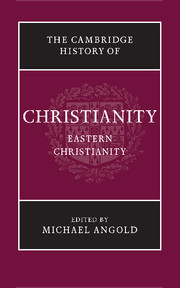Book contents
- Frontmatter
- PART I THE ECUMENICAL PATRIARCHATE
- PART II THE RUSSIAN CHURCH
- 11 Russian piety and Orthodox culture 1380–1589
- 12 Art and liturgy in Russia: Rublev and his successors
- 13 Eastern Orthodoxy in Russia and Ukraine in the age of the Counter-Reformation
- 14 The Russian Orthodox Church in imperial Russia 1721–1917
- 15 Russian piety and culture from Peter the Great to 1917
- PART III EASTERN CHRISTIANITIES
- PART IV THE MODERN WORLD
- Bibliography
- Index
- References
11 - Russian piety and Orthodox culture 1380–1589
from PART II - THE RUSSIAN CHURCH
Published online by Cambridge University Press: 28 March 2008
- Frontmatter
- PART I THE ECUMENICAL PATRIARCHATE
- PART II THE RUSSIAN CHURCH
- 11 Russian piety and Orthodox culture 1380–1589
- 12 Art and liturgy in Russia: Rublev and his successors
- 13 Eastern Orthodoxy in Russia and Ukraine in the age of the Counter-Reformation
- 14 The Russian Orthodox Church in imperial Russia 1721–1917
- 15 Russian piety and culture from Peter the Great to 1917
- PART III EASTERN CHRISTIANITIES
- PART IV THE MODERN WORLD
- Bibliography
- Index
- References
Summary
Introduction
The chronological span of this chapter begins with the victory of Grand Prince Dmitrii of Moscow over a Tatar army at Kulikovo Field, a battle supposedly blessed by St Sergii of Radonezh and recognised as a defining spiritual, as well as political, moment in the life of the nation: as many disparate responses over the intervening centuries bear witness, from the near-contemporary versions of the Kulikovo Tale (Zadonshchina) to Aleksandr Blok’s classic poetic cycle On Kulikovo Field and the canonisation in 1988 of Dmitrii (honoured with the title Donskoi, ‘of the Don’).Ourperiod ends with the creation of the Russian patriarchate, formal recognition of the autocephalous status of the Russian Orthodox Church, shortly to be followed by the extinction of the first Russian royal dynasty and the ‘Time of Troubles’. The interim period represents the gradual formation of what is generally called ‘national consciousness’: the spiritual, cultural and political transformation of a disparate collection of warring principalities forming mobile alliances with their Catholic, pagan and Muslim neighbours and overlords for economic or political gain, into an Orthodox nation, unified under tsar and patriarch and self-consciously promoting both a national faith and an ideology of a faithful nation.
This is the traditional, simplified, even mythologised, overview of a crucial period in Russian history and the history of the Russian Orthodox Church. Transformation from disparate principalities to centralised Muscovite state indeed took place, but the process was less linear and the details were less definite than is generally allowed. It is by no means certain, for example, that St Sergii blessed Dmitrii’s 1380 venture, nor was the battle a decisive victory – the Tatars continued to exact tribute from the Russian lands until the late fifteenth century.
- Type
- Chapter
- Information
- The Cambridge History of Christianity , pp. 251 - 275Publisher: Cambridge University PressPrint publication year: 2006
References
- 2
- Cited by



